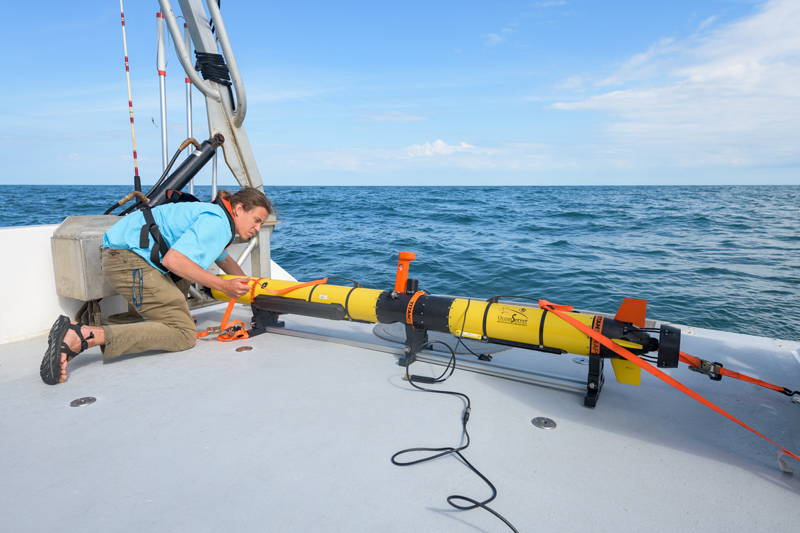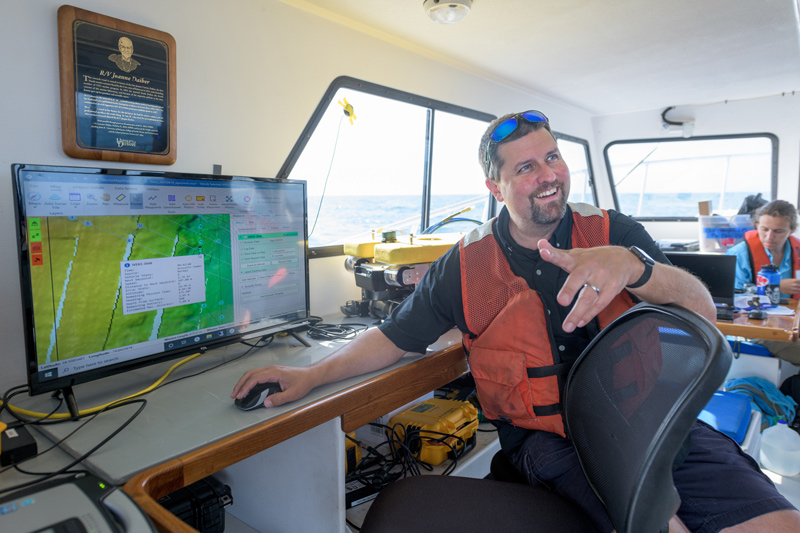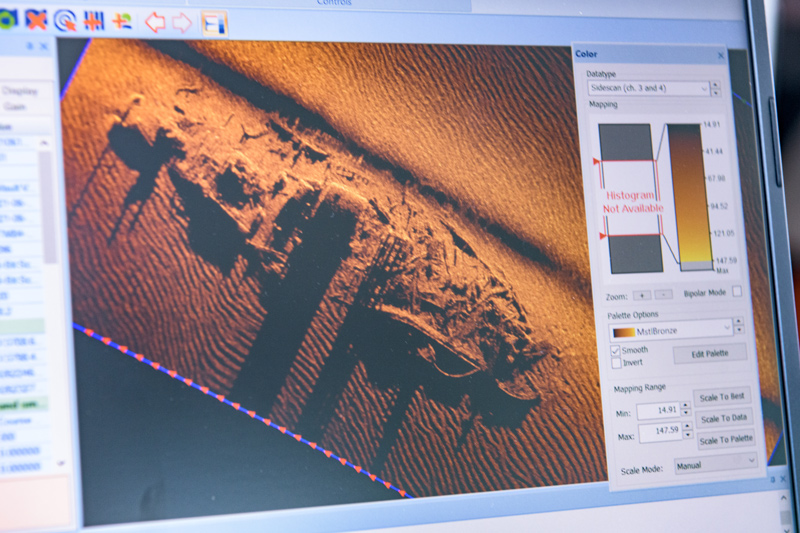


Mystery of the USS Nina
Photos by Evan Krape October 04, 2021
UD-led research team identifies the site of 1910 shipwreck off the coast of Delaware
In 1910, the Navy steamer tug known as the USS Nina sank off the coast of Delaware and Maryland with more than 30 people aboard.
Since that time, the official location of the shipwreck has remained a mystery. Now, thanks to a joint effort by the University of Delaware, the U.S. Navy and SEARCH, Inc. (SEARCH), the site has been confirmed. This expedition helps bring peace to the descendants of those who were lost on that day and allows the Navy to begin the process of protecting this watery grave site.
Serendipitous timing
Art Trembanis, professor in the College of Earth, Ocean and Environment (CEOE), said that the joint effort came about through years of friendships and personal collaborations, as well as the stars aligning to allow for the search to take place.
Having just received a new autonomous underwater vehicle (AUV), Trembanis was looking for ways to test it out on the water. He spoke with Jim Delgado, senior vice president of SEARCH, a leading U.S.-based cultural resource management company, and Delgado told him about the USS Nina.
Trembanis also had a group of United States Naval Academy students, known as midshipmen (Mids), interning with him at CEOE’s School of Marine Science and Policy at the same time. Since 2015, 18 Mids from the U.S. Naval Academy (USNA) have come to UD and participated in a summer instructional internship through an Educational Partnership Agreement (EPA) between UD and the USNA. Many of these students have gone on to incorporate their skills and experiences into senior capstone projects.
“Those things aligned and I said, ‘Well why not instead of having a make-believe type of mission, why don’t we have an honest-to-goodness, real, challenging expedition to exercise the vehicle and help address a Navy site and long-standing mystery?’” said Trembanis. “I thought it would be something for our students to chew on and give them something to lead and execute.”
Hands-on Experience
With their mission set to carry out the investigation, the UD students got to work coordinating with the team members from SEARCH and the midshipmen. Trembanis made it clear that they had all the resources from their lab available to them, including AUVs, aerial drones and remotely operated vehicle (ROV) systems.

They were also able to use UD’s coastal research vessel, the R/V Joanne Daiber, to conduct day trip surveys out on the water studying the site.
Two UD doctoral students who were heavily involved in the mission were Kaitlyn McPherran and Mark Lundine.
McPherran helped the midshipmen plan and prepare for the mission, and also instructed them on how to use the AUVs. When she was out on the ship, she and Lundine flew drones to record the search proceedings from the air, and she also helped the midshipmen process the sonar and bathymetry data to give them an idea of what they were seeing.
Lundine was out on the ship for two days doing the exploration and helping with the mission plans for the AUV. Along with operating the drone, Lundine also helped with deploying and recovering the robotic instruments used to map the wreck site.
He also took the camera images and wrote the code that allowed him to lay out images of the wreck site geographically.
“The more you get experience using these systems—using all of this technology in our lab, working with all of the data from the different sites—you learn more each time,” said Lundine. “This was such a unique opportunity. The crash was right off the coast of Delaware, and it was so interesting to get this hands-on experience so close to the campus.”

McPherran and Lundine both said that it was great to bring closure to some of the families and positively identify the shipwreck, which will help the Navy put things in motion to help better protect the site.
She added that getting this type of hands-on experience shows the value of UD’s campus in Lewes.
“Our campus is right next to a lot of our fieldwork sites for our projects and that helps get us out there on the water,” said McPherran. “You can go out for a day and use all kinds of instruments, and it’s a really good opportunity, especially for the undergrads and the interns.”
Preserving the site
Trembanis said that there had been previous attempts to identify the Nina, but this was the first comprehensive, high-resolution investigation of the site. In addition, divers found the site in the 1970s and have been picking pieces off the ship ever since. To prevent further looting, it was important for the Navy to have independent verification of the site to start the process of having the Naval History and Heritage Command (NHHC) officially identify the Nina in order to classify the site and protect the craft.
There is also plenty of follow up work to be done but now that the team was able to successfully identify the Nina and the site, they have a snapshot of how the ship looks currently and can use that data to compare with any future work.
Trembanis said the autonomous systems they used allowed them to map the ship thoroughly and in a short period of time — if they had to use divers to map the wreck, Trembanis said they would probably still be out there working on the site.
He also credited the interdisciplinary nature of the work.
“The Navy has thousands of these cases, and we’ve already started talking with NHHC and SEARCH about what might be our next joint investigation,” Trembanis said. “For this project, we garnered some useful information for them, but it also confirmed the value and the strength of these partnerships. It gave our students some exposure to those communities and how the research, technologies and the techniques they’re learning are directly relevant to those groups. It shows that when you have these sorts of public/private industry or military partnerships, you can do some pretty amazing things.”
Contact Us
Have a UDaily story idea?
Contact us at ocm@udel.edu
Members of the press
Contact us at 302-831-NEWS or visit the Media Relations website

